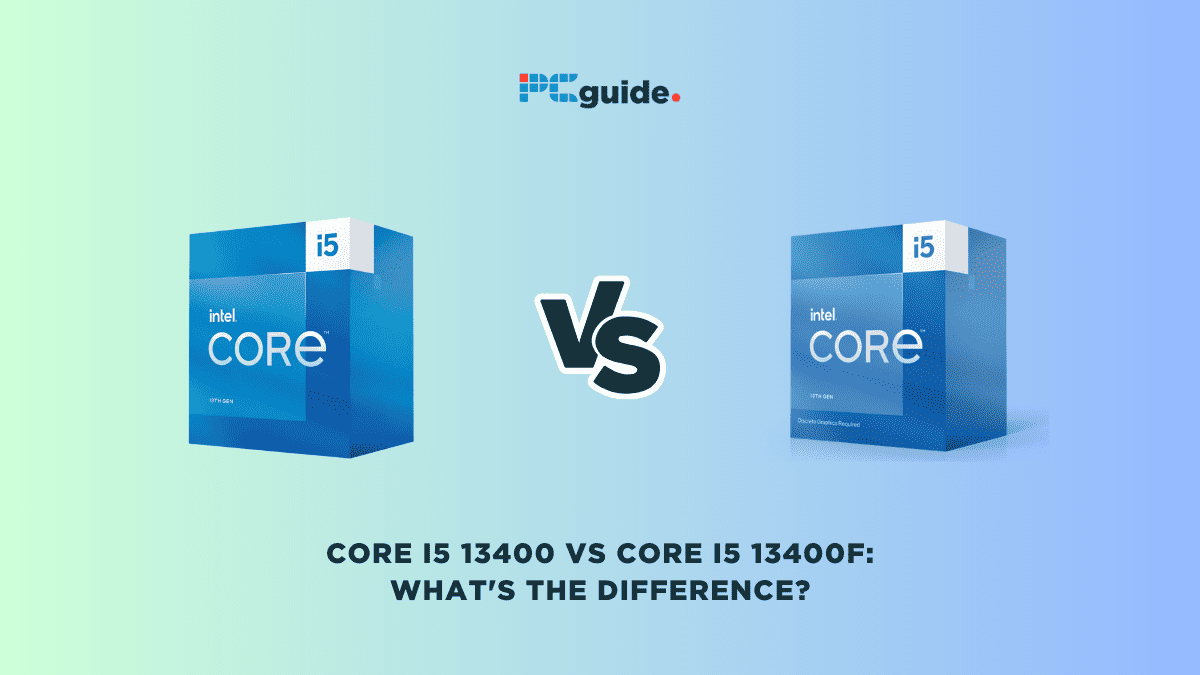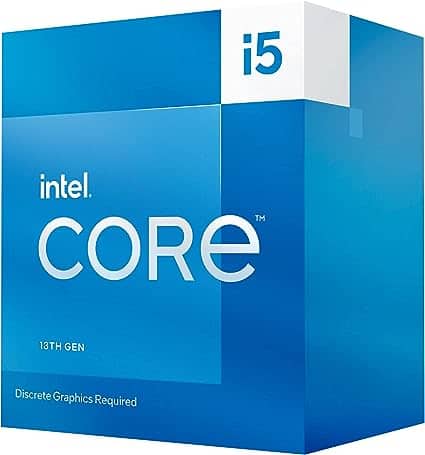Core i5 13400 vs Core i5 13400F: What’s the difference?

Table of Contents
In this article, we delve into the comparison of Core i5 13400 vs. Core i5 13400F, examining what sets these two similar-sounding processors apart. This comparison is particularly relevant for users looking to build or upgrade their PCs, as understanding the subtle, yet significant differences between these CPUs can greatly impact the overall system performance and suitability for specific tasks.
The primary difference between the Core i5 13400 and the Core i5 13400F models lies in their graphics capabilities. The Core i5 13400 comes equipped with onboard graphics. In contrast, the “F” designation on the Core i5 13400F indicates the absence of integrated graphics.
Core i5 13400 vs. Core i5 13400F: Specs
Both CPUs are built on Intel’s 10nm processing node, offering a balance of power efficiency and performance. Each features 10 cores and 16 threads, providing a solid foundation for multitasking and demanding applications. The base frequency for both is set at 2.5 GHz, with the capability to turbo up to 4.6 GHz when required, ensuring that they can handle intensive tasks with relative ease.
Memory compatibility is identical for the two models, supporting both DDR4-3200 and DDR5-4800. This flexibility allows users to choose between the more affordable DDR4 or the faster and more future-proof DDR5 memory, depending on their needs and budget. The TDP for both processors is rated at 65W, indicating that they have similar power consumption and heat output profiles.
| Features | Core i5 13400F | Core i5 13400 |
|---|---|---|
| Processing Node | 10nm | 10nm |
| Cores / Threads | 10 / 16 | 10 / 16 |
| Frequency | 2.5 GHz | 2.5 GHz |
| Turbo Clock | up to 4.6 GHz | up to 4.6 GHz |
| Memory | DDR4-3200 / DDR5-4800 | DDR4-3200 / DDR5-4800 |
| TDP | 65W | 65W |
| Max. Operating Temperature | 100°C | 100°C |
| L1 Cache | 80K (per core) | 80K (per core) |
| L2 Cache | 1.25MB (per core) | 1.25MB (per core) |
| L3 Cache | 20MB (shared) | 20MB (shared) |
| Integrated Graphics | – | UHD Graphics 730 |
| Price | $196 | $221 |
The key distinction lies in the integrated graphics. The Core i5 13400 includes Intel’s UHD Graphics 730, providing basic graphic capabilities suitable for everyday tasks and light gaming. In contrast, the Core i5 13400F lacks an integrated GPU, necessitating a discrete graphics card for any graphical output.
Core i5 13400 vs. Core i5 13400F: Performance
When comparing the Intel Core i5 13400 and Core i5 13400F, we find subtle yet significant differences in their performance and value. Both CPUs are a testament to Intel’s prowess in creating efficient and powerful processors, but they cater to different user needs.
Multi-core and single-core performance
One of the key differences between the Core i5 13400 and the Core i5 13400F is their multi-core and single-core performance. The Core i5 13400 has a slight edge in multi-core tasks, thanks to its higher base clock of 3.1 GHz and its integrated graphics (UHD Graphics 730). This makes it more suitable for applications that can utilize multiple CPU cores, such as video editing, 3D rendering, or running multiple programs at once.
The Core i5 13400F, on the other hand, has a lower base clock of 2.9 GHz and lacks integrated graphics, requiring a discrete GPU. However, it compensates with a higher boost clock of 4.8 GHz and a lower TDP of 65 watts, giving it an advantage in single-core tasks. This means it can handle applications that rely on fast single-core performance, such as gaming, web browsing, or office work.
Integrated graphics and hardware compatibility
A key differentiator is the integrated graphics (iGPU) in the Core i5 13400. Equipped with Intel’s UHD Graphics 730, it suits users who require a processor for everyday computing, light content creation, and casual gaming, without the extra cost of a dedicated graphics card.
Architecture and memory support
Both CPUs are built on Intel’s advanced architecture, supporting DDR4-3200 and DDR5-4800 memory, catering to a range of user preferences and budgets. This flexibility in memory compatibility ensures that users can optimize their systems based on their specific needs and existing hardware.
Thermal design and power efficiency
Thermal management is a crucial aspect of these CPUs. Both maintain a balance between performance and heat generation, ensuring longevity and reliability. The Core i5 13400F, in particular, stands out for its efficient thermal design, making it a better value for users concerned with long-term performance and energy consumption.
Motherboard compatibility
Compatibility with various motherboards is another factor to consider. Both CPUs fit perfectly into a range of desktop setups, allowing users to choose a motherboard that aligns with their performance requirements and budget constraints.
In conclusion, the choice between the Core i5 13400 and Core i5 13400F depends on individual needs. Whether it’s for enhanced multi-core performance, efficient single-core tasks, or the convenience of integrated graphics, both CPUs offer compelling reasons for their selection.
Predecessor Comparisons and Desktop Integration
It’s also beneficial to compare these CPUs with their predecessors to understand the improvements and value they bring. Both the Core i5 13400 and 13400F show advancements in processing power and efficiency, making them worthy successors in Intel’s lineup of desktop CPUs.
In conclusion, while the Core i5 13400F presents a lower upfront cost, the Core i5 13400’s integrated graphics offer a more complete package for immediate use. Users should weigh these factors against their specific needs and the total cost of building or upgrading their desktop systems.
What is the difference between P-cores and E-cores?
P-cores are designed for high-performance tasks, while E-cores are designed for energy efficiency. Raptor Lake processors can dynamically allocate tasks between P-cores and E-cores to optimize performance and power consumption.
Which processor is better for gaming, the Core i5 13400 or Core i5 13400F?
For gaming, the Core i5 13400F is the better choice, as it offers slightly better single-core performance compared to the Core i5 13400. However, it’s important to note that the real-world difference in gaming performance between the two processors is minimal. Additionally, the Core i5 13400’s integrated graphics may be sufficient for some light gaming or casual use.
Core i5 13400 vs. Core i5 13400F: Price
When evaluating the Core i5 13400 and Core i5 13400F, price plays a significant role in determining their overall value. Each model offers distinct advantages that impact the total cost of ownership.
Initial cost vs. long-term value
The Core i5 13400F, known for its lower Manufacturer’s Suggested Retail Price (MSRP), initially seems like the more economical choice. However, its lack of integrated graphics (indicated by the “F” in its name) means users must invest in a separate graphics card. This additional expense can substantially increase the total cost, especially considering the current market prices for discrete GPUs.
On the other hand, the Core i5 13400 includes Intel’s UHD Graphics 730. This integrated GPU makes the 13400 a more comprehensive solution for users who need a processor for general computing, office applications, and light creative tasks, without the need for additional hardware.
| Feature | Core i5 13400F | Core i5 13400 |
|---|---|---|
| MSRP | $281 | $314 |
| Integrated Graphics | None | Intel UHD Graphics 730 |
| Additional Graphics Card Required? | Yes | No |
| Estimated Cost of Entry-Level Graphics Card | $100 | N/A |
| Estimated Cost of Mid-Range Graphics Card | $200 | N/A |
| Estimated Cost of High-End Graphics Card | $500 or more | N/A |
| Total Cost with Entry-Level Graphics Card | $381 | $314 |
| Total Cost with Mid-Range Graphics Card | $481 | $314 |
| Total Cost with High-End Graphics Card | $881 or more | $314 |
In contrast, the Core i5 13400, while priced higher than its F variant, includes Intel’s UHD Graphics 730. This integrated GPU capability makes the 13400 a more complete package straight out of the box, capable of handling general computing tasks, office work, and light content creation.
While the Core i5 13400F presents a lower upfront cost, the Core i5 13400’s integrated graphics offer a more complete package for immediate use. Users should weigh these factors against their specific needs and the total cost of building or upgrading their desktop systems.
Core i5 13400 vs. Core i5 13400F: Conclusion
In concluding the comparison between the Core i5 13400F and the Core i5 13400, it’s clear that the choice between these two processors hinges on specific user requirements and the overall system they envision. The Core i5 13400F, with its lower initial price, caters to users who prioritize robust CPU performance and are prepared to complement it with a dedicated GPU.
On the other hand, the Core i5 13400, despite its higher upfront cost, offers a more complete and versatile package right out of the box. The inclusion of integrated graphics makes it suitable for a range of general computing tasks, from office work to light content creation, without the immediate need for a separate graphics card.

